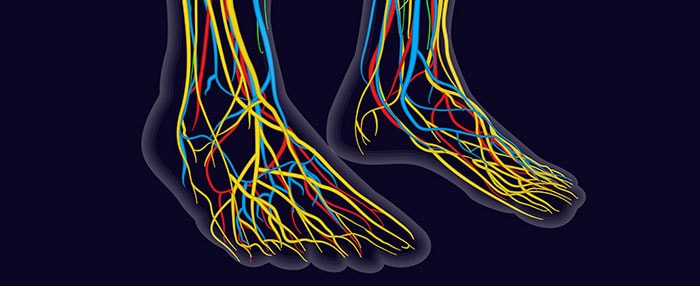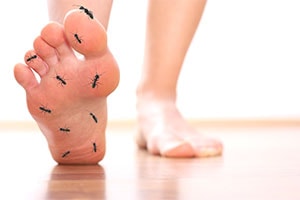
Almost everyone is familiar with diabetes. But many people aren’t aware of just how many complications accompany high blood sugar levels. Among these diabetes complications are a variety of diabetic foot problems.
Today we’re going to focus on the diabetic nerve conditions diabetic neuropathy and nerve compression.
All About Diabetic Neuropathy
High blood glucose levels go hand-in-hand with nerve conditions. This is because the high blood sugar levels injure nerves, resulting in pain, tingling, and even complete loss of sensation.
There are different types of diabetic neuropathy that affect different parts of the body.
Dr. Baravarian discusses diabetic nerve damage
Autonomic Neuropathy
The autonomic nervous system controls involuntary bodily functions including blood pressure, digestion, bladder function, and sexual function, among others. This type of nerve damage interferes with the messages sent between the brain, organs, and other areas of the autonomic nervous system, such as blood vessels and sweat glands.
Symptoms include:
- digestive issues, including diarrhea, constipation, nausea, or loss of appetite
- dizziness and fainting when standing
- difficulty regulating body temperature, including excessive or insufficient sweating
- sexual dysfunction
Proximal Neuropathy
Also known as diabetic amyotrphy, this form of neuropathy is rare and most commonly seen in adults over 50 with fairly well-controlled type 2 diabetes. It often affects the hips, buttocks, and thighs, and usually only affects one side of the body.
Symptoms include:
- sudden and sometimes severe pain
- muscles weakness in the legs
Focal Neuropathy
Also called mononeuropathy, focal neuropathy occurs when there’s damage to one specific nerve or nerve group. It occurs most often in the hand, head, torso, or leg. It appears suddenly and is very painful. About 25% of people with diabetes have some degree of nerve compression at the wrist; the most common type is carpal tunnel syndrome.Symptoms include:
- pain, numbness, or tingling in fingers
- inability to focus
- double vision
- aching behind the eyes
- Bell’s palsy (facial muscle weakness or paralysis)
- pain in isolated areas
Peripheral Neuropathy
Peripheral neuropathy is the most common type of nerve damage. It affects the peripheral nervous system (the nerves outside the brain and spinal cord) and is most common in the feet and legs. It can also affect the arms and hands.
Diabetes neuropathy symptoms include:
- numbness
- tingling or burning sensations
- extreme sensitivity to touch
- insensitivity to hot and cold temperatures
- sharp pain or cramping
- muscle weakness
- loss of balance or coordination
If you have diabetes and notice numbness, tingling, pain, or weakness in your hands or feet, make an appointment with your doctor. Diabetic peripheral neuropathy develops slowly, sometimes over the course of decades, so the earlier we catch it the better!
Diabetic neuropathy also puts you at higher risk for injury or infection. In extreme cases, an ulcer or improperly healed wound can require amputation.
Nerve Compression In Foot
Diabetes can also result in nerve compression. In regular nerve compression, one nerve in the arm or leg becomes constricted or compressed. This results in numbness in that single region.
Diabetic nerve compression is the result of a metabolic imbalance that causes nerves to become swollen. This inflammation influences tightness in the surrounding area and increased pain. A diabetic’s nerves are susceptible to compression because the nerves are swollen.
When to See a Doctor
There is no known cure for diabetic neuropathy, so it’s important to get it diagnosed early so we can start managing your neuropathic pain.

If you notice any of the following symptoms of diabetic neuropathy, call your healthcare team:
- A cut or sore on your foot that is infected or won’t heal
- Burning, tingling, weakness, or pain in your hands or feet that interferes with daily activities
- Changes in digestion, urination, or sexual function
- Dizziness and fainting
The American Diabetes Association recommends diabetic patients begin screening for diabetic neuropathy immediately after being diagnosed with type 2 diabetes or five years after being diagnosed with type 1 diabetes. Repeat screening annually.
Diagnosing Diabetic Feet Issues
Your doctor can generally diagnose diabetic neuropathy through a physical exam and review of your symptoms and medical history.
During your office visit your doctor will check:
- overall muscle strength and tone
- reflexes
- sensitivity to touch and vibration
Your doctor may also perform more specific tests to diagnose diabetic neuropathy:
Filament Test: A monofilament (soft nylon fiber) will be brushed over areas of your skin to test sensitivity to touch.
Sensory Testing: A noninvasive test that measures how your nerves respond to vibration and temperature changes.
Nerve Conduction Testing: This test, often used to diagnose carpal tunnel syndrome, measures how quickly your nerves conduct electrical signals.
Muscle Response Testing: Also known as electromyography, this test measures electrical discharges produced in your muscles. It’s often done with nerve conduction studies.
Autonomic Testing: These special tests determine how your blood pressure changes when you’re in different positions and if you sweat normally.
Diabetic neuropathy treatment
There is currently no known diabetic neuropathy cure. Treatment goals are to slow the progression, relieve pain, manage complications, and improve quality of life.
The key to delaying (or outright preventing) nerve damage is to keep blood sugar within its target range. Proper blood sugar management can even improve existing symptoms. Based on your age, overall health, and how long you’ve had diabetes, your doctor will determine your blood sugar level’s target range. According to the National Institute of Diabetes and Digestive and Kidney Diseases, bringing blood sugar into a healthy range reduces the risk of nerve damage by 60%.
For pain management, prescription pain killers may be useful. Interestingly, some types of antidepressants and anticonvulsants can relieve nerve pain. These are often combined with over-the-counter pain medications or lidocaine patches for numbing pain.
The American Academy of Neurology’s guidelines for treating painful diabetic neuropathy (PDN) say the most effective medications are:
- pregabalin (Lyrica)
- gabapentin (Neurontin)
- duloxetine (Cymbalta)
- venlafaxine (Effexor) amitriptyline
Some patients benefit from alternative pain relief therapies such as:
Capsaicin cream: When applied to the skin, it can reduce pain sensations. However, it can also cause a burning sensation and skin irritation.
Alpha-lipoic acid: A powerful antioxidant found in spinach, red meat, beats, and other foods. In some people, it helps relieve nerve pain symptoms.
Acetyl-L-carnitine: A nutrient naturally made by the body and also available as a supplement. In some people, it helps relieve nerve pain.
Transcutaneous electrical nerve stimulation (TENS): This therapy can prevent pain signals from reaching the brain. TENS delivers tiny electrical impulses to specific nerve pathways. The treatment is safe and painless but doesn’t work for all people or all types of pain.
Acupuncture: Generally free of side effects, acupuncture may help relieve neuropathy pain. However, you will most likely need more than one session to get relief.
Check with your doctor to discuss what pain relief treatment is best for you. If you’re considering alternative therapies, your doctor will have to check for potential interactions with existing treatments.
Diabetic neuropathy prevention
As previously mentioned, since diabetic neuropathy can’t be cured, it has to be prevented! Important things you can do at home to slow or prevent neuropathy are to stay active, eat well, maintain a healthy weight, and keep your blood pressure under control!
One piece of good health advice for everyone: don’t smoke! And if you do smoke, quit! Using tobacco in any form makes you more likely to develop poor circulation. Poor blood flow in your feet makes healing take longer and increases your risk of complications.
Regular diabetic foot exams are critical.
Diabetic neuropathy FAQs
Q: What exactly causes diabetic neuropathy?
A: Blood glucose enters the nerve to provide energy as it does in other cells. The glucose is then converted into sorbitol, which attracts water molecules. This extra water causes the nerve to swell. If the nerve is in a place that’s already tight, such as the hands and feet, the nerve becomes compressed.
Q: Will diabetic neuropathy go away?
A: No. We can take steps to slow its progression and manage the complications, but it won’t just go away on its own.
Q: Should I have surgery?
A: Surgical decompression can be performed to remove the tight areas along the course of the nerve. Surgery won’t remove the underlying cause but can restore blood flow and allow the nerve to recover or regrow.
Q: What are the major risks of peripheral neuropathy?
A: Damage to the peripheral nerves makes it hard (or impossible) to feel injuries on the feet. Untreated sores and cuts can become infected. Over time, these infections worsen and may lead to irreparable damage or amputation. So it’s very important to get diagnosis and treatment as early as possible.
Why choose University Foot and Ankle for your diabetic foot care?
Whether you’re already living with diabetic neuropathy or just want advice on caring for your diabetic feet, our nationally recognized foot and ankle doctors offer the most advanced foot care and the highest success rates in the nation. We are leaders in the research and treatment of all foot and ankle conditions.
At University Foot and Ankle Institute, we take our patients’ safety seriously. Our facility’s Covid-19 patient safety procedures exceed all CDC recommendations. Masks are required in our institutes at all times.
For more information or to schedule a consultation, please call (877) 736-6001 or make an appointment now.
We are conveniently located through the Los Angeles area with locations in or near Santa Monica, Beverly Hills, West Los Angeles, Manhattan Beach, Northridge, Downtown Los Angeles, Westlake Village, Granada Hills, and Valencia, California.
- The Power of Pediatric Flexible Flatfoot Procedures - September 21, 2023
- StimRouter: A Revolutionary Approach to Targeted Pain Relief - August 21, 2023
- Is Cosmetic Foot Surgery Safe? Or Are You Starting Off on the Wrong Foot? - May 17, 2023
Leave a Reply